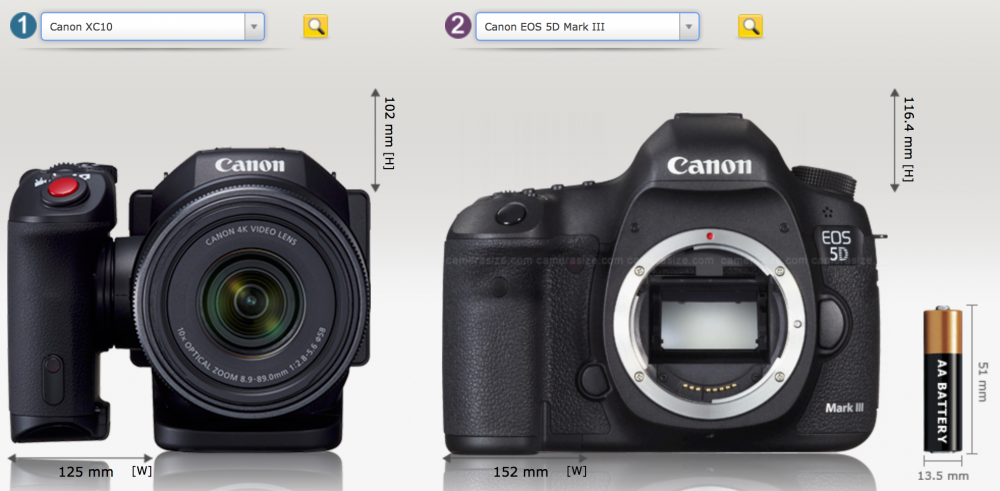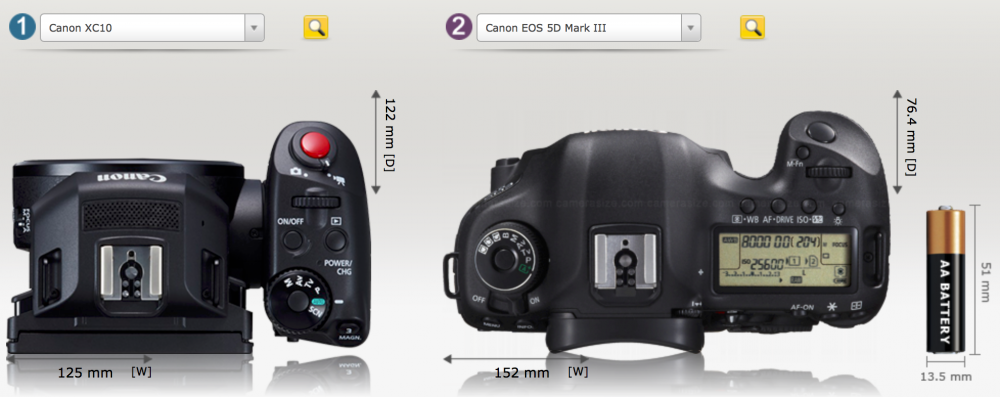-
Posts
7,991 -
Joined
-
Last visited
Content Type
Profiles
Forums
Articles
Everything posted by kye
-
It's not that hard to cool a sensor in a small body. The Canon XC10 has air cooling with fans, and it's a very compact body. Here it is vs a 5D mkIII body:
-
I know that's how it works @IronFilm but it just seemed a little too far from <common sense / normal humans / the real world> to leave hanging... the film industry is a very strange place where Low Budget can mean $400,000 and No Budget can mean $2,200 (link link). That puts a $100 film in the "I Haven't Eaten In A Week Budget" category, and yet it still got a $15,000 camera!
-
I'm not sure what you should choose, but here's a handy list of codecs that might inspire you? https://blog.frame.io/2017/02/13/50-intermediate-codecs-compared/ I would imagine your decision would revolve around quality vs bitrate.
-
Plus, since Homo Erectus, people are vertical creatures... so it's almost a mystery as to why video began in landscape. BUT, if you consider that most TV / movies are people standing next to each other it makes total sense. Now with the rise of vertical video and lots of videos of a single person talking to camera it almost seems like these might be connected?!?!!?
-
All this talk of a bazillion stops of DR, I'm reminded of the minor miracle that these manufacturers have managed to accomplish.. 10 stops of dynamic range means that in comparison to the smallest amount of light they can distinguish, the brightest light it can distinguish is 1024x. That doesn't sound like much, but 12 stops is 4096x, 14 stops is 16384x, and 16 stops would be 65535x!!!! Even the claimed 13 stops for the Pocket 4K is 8192x.. that's huge! We really are spoiled ???
-
Now all the YouTubers who record IGTV and YT content will be hassling monitor companies for "flippy screens" as well as Sony!
-
I may be nit-picking, but there might be a difference between what the customers want at home and what will make it sell on the shop floor. There's a thing with hifi speakers about treble - manufacturers deliberately turn the treble up too high because on the shop floor it makes them sound 'detailed' and so they out-sell the other speakers in the line-up, Of course, at home, in a quiet, much more absorbing environment, the speakers sound bad and will be fatiguing. Tests show that more treble is preferable when doing a quick test, but when doing a longer test more balanced speakers win out.
-
Interesting. Maybe it's a legacy thing for adapters? I would imagine that their product design would be pretty sophisticated - they've been at/near the top for a long time!
-
If it's going to last another 100 years, designing it with more pins than you think you'll need, or even some spares would make sense. Who knows what kind of currently-unknown technologies will come into play during that time..
-
Do you think that "high resolution" means the kind of high-but-existing resolutions like the 40-50MP sensors we have already, or beyond those to 100+MP? If you were asking stills shooters what the new we-built-a-new-architecture-from-the-ground-up camera would include, I'm not surprised they'd want more MP rather than less. You have to take a lot of photos for storage sizes and write performance to be anything like we face in video, but more MP means you can crop, do better NR, and all kinds of other things which are useful in the real world. Like we talk about 4K giving the possibility to downscale or crop to 1080 but potentially having a much larger crop factor than 2. Stills is a different game to video.
-
I think we need to distinguish between "cash budget" and "total budget". You might have shot that film for $100, but if my neighbours kid wants to shoot a film for $100, they're going to run out of money after they buy a Chinese tripod and smartphone mount, a Lav from eBay and couple of halogen floodlights from the hardware store. And they started with their own camera and you didn't!
-
I'd be surprised if they didn't. The vlogging community has been jumping up and down about a "floppy screen" and great AF, but all the Sony vloggers have learned to vlog without seeing the screen, and GH5 users have learned about MF, so it's possible. Considering that run and gun docos, corporate gigs, and the like are more controlled and slower paced affairs (certainly than the grind of daily vlogging) so MF and other limitations are surmountable. People have been running and gunning at close to the same pace probably since auto-exposure. and with film there was no preview window
-
Article: https://www.hollywoodreporter.com/behind-screen/netflix-mode-comes-new-sony-master-series-tvs-1130621 Looks like the industry is gradually getting colour and gamma standards in place..
-
How many people here use natural or practical lighting vs dedicated lighting setups? Personally I shoot natural / practicals the whole way, because my work doesn't have a 'set'.
-
No! You have to shoot in that lane... everyone knows if you're in the left-hand-lane your skin goes all funny!
-
In the absence of someone more knowledgable than me replying, one thing I have heard is that for compositing (ie, combining 3D renders into the footage) you want as much precision in the footage as possible so the tracking can be good enough. This suggests rendering out of Resolve with a very high quality codec. Perhaps something like Prores 4444 HQ?
-
Can someone clarify the debate around the colours for me? There seems to be two kinds of comments.. the "Sony colours are bad" type comments, and the "colours look fine to me" comments. The A7III colours look fine to me, but I'm definitely not the biggest connoisseur in that department. Do the "Sony colours look bad" comments include the A7III? I have seen comments around the A7III having the Venice colour science, so perhaps it's other Sony cameras that these comments are referring to? Thanks! @jonpais thanks for that upload - the amount of detail is really impressive.. downscaling 6K seems to be a winner!
-
My previous offer to "store" your excess camera gear at my house still stands!!
-
Thanks for the update!! The way I view this camera is for high quality in relatively controlled conditions - so the lack of features like fast AF and NR seems appropriate. Pulling focus manually is the norm for a cinema camera, and the lack of NR is actually an advantage I think because you can de-noise carefully in post, using the Resolve spatial and temporal NR features or plugins, for the best possible result. The substantial crop in windowed 1080 is encouraging, as for those capturing in 1080 it gives a good extension to their existing lens collection. The more I hear about this camera the more I think that BM is going to absolutely nail it for the low budget film-maker. Bring on the Pocket2 vs ARRI youtube clips!
-
Makes sense... everyone knows that we are 1% slimmer in 4K FF!!
-
I would answer your question with another question.... Where does the money come from?
-
That's interesting to me as well, not because of Prores RAW, but because it's a positive reflection for Slog2.
-
Yep, and here's what he does with that kind of responsibility...
-
I think it's easier said than done finding quality channels. You can't search for people that are intelligent, edit their content well, or are highly skilled... unfortunately! I think content-per-minute is the defining factor. It's a big differentiator between UK and US TV - I've found it common for the UK to put a similar amount of content in a 6 episode season that a US show might put in a 22 episode season. (Obviously there are exceptions on both sides!). YouTubers often have pretty low content-per-minute unfortunately.
-
Even then, the cost of the bodies might have been cheaper than paying everyone to mill around waiting for the lighting to be moved and fine-tuned in setup after setup after setup. I remember the first student film set I was on had a girl sitting at a table in a cafe, at first alone and then she was joined by someone else and they had a conversation. There was a small vase with a flower in it on the table and it took about 2-3 minutes every time we changed camera angles to move the flower to somewhere that looked remotely natural. I think it ended up covering about half the tables surface, and we all had a good laugh when both the Director and AD swore that they would never let an art director put a flower on a table ever again!!





